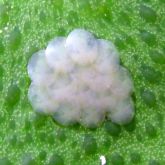Citrus fruit borer
Alert
Be on the lookout for citrus fruit borer.
Report sightings
- Report online
- Call Biosecurity Queensland 13 25 23
- Call the Exotic Plant Pest Hotline on 1800 084 881.

Citrus fruit borer damage to fruit includes holes associated with caterpillar frass or gumming
© Mrs. Srijumnun Srijuntra, Plant Pest Management Research Group, Department of Agriculture, Thailand

Citrus fruit borer adult moth
© Mrs. Srijumnun Srijuntra, Plant Pest Management Research Group, Department of Agriculture, Thailand

Citrus fruit borer eggs
© Mrs. Srijumnun Srijuntra, Plant Pest Management Research Group, Department of Agriculture, Thailand

Citrus fruit borer caterpillar
© Mrs. Srijumnun Srijuntra, Plant Pest Management Research Group, Department of Agriculture, Thailand

Citrus fruit borer pupa
© Mrs. Srijumnun Srijuntra, Plant Pest Management Research Group, Department of Agriculture, Thailand

Citrus fruit borer caterpillar burrowing into citrus fruit
© Mrs. Srijumnun Srijuntra, Plant Pest Management Research Group, Department of Agriculture, Thailand
The caterpillar of the citrus fruit moth (Citripestis sagittiferella) is known as the citrus fruit borer. The borer is a serious threat to the citrus industry because it burrows into the fruit rind, and eventually the fruit flesh, causing internal rot and fruit drop. Besides decreasing productivity and market value due to scarring of fruit and fruit becoming inedible, market access could also be affected.
Citrus fruit borer is not known to occur in Australia.
Cause
The caterpillar of the citrus fruit moth (Citripestis sagittiferella) is known as the citrus fruit borer. It is an exotic citrus insect pest.
Other names
- Citrus pulp borer
- Lemon fruit borer
- Citrus fruit moth
Description
Adults
- Adult moths are about 10mm long and have a wing span of about 27mm.
- The moths are grey-brown with yellow to grey-brown forewings and almost transparent hind wings.
Larvae
- The caterpillars are orange to dark reddish-brown with a dark brown head, and can grow up to 21mm long.
- The larvae can be fast moving and jump and twist when touched.
Pupae
- Caterpillars turn dark green when pupating.
- Caterpillars fall to the ground on silken threads and pupate in the soil for about 10 days.
Eggs
- The oval, whitish eggs are laid in clusters on the underside of citrus fruit. Eggs turn from pearly white to reddish brown in colour as they develop.
Plant stage and plant parts affected
- Fruit of plants in the family Rutaceae, particularly citrus.
Plant damage
- The borers leave minute holes in the fruit rind, and cavities under the fruit surface.
- These holes might be associated with caterpillar frass or gumming.
- Internal fruit rots introduced by borers can lead to fruit drop.
May be confused with
The orange fruit borer (Isotenes miserana) found in Queensland could be confused with citrus fruit borer. Orange fruit borer caterpillars differ though, they are brown on top and light grey underneath, with a dark brown head capsule and a pair of brown stripes along the body.
Distribution
Citrus fruit borer occurs in South-East Asia (Indonesia, Malaysia, Singapore, Vietnam and Thailand).
It is exotic to Australia.
Hosts
Citrus, and some other plants in the family Rutaceae.
Life cycle
- The adult female moth lays eggs on citrus fruit.
- Caterpillars hatch from the eggs about 5 to 6 days later.
- Young caterpillars bore into the citrus peel, then tunnel into the pith and citrus flesh, where they feed and grow for the next 9 to 17 days.
- Once mature, the caterpillars descend to the ground on silken threads and pupate in the soil.
- The adult moth emerges from the pupal cocoon after 9 to 11 days.
- Adult moths are strong flyers and capable of flying further in search of citrus plants.
Impacts
Citrus is a significant crop in Australia with over 23,000 hectares of citrus planted. For the year ending June 2023, citrus production was valued at $977.1 million, with Queensland the largest producer of mandarins, lemons and limes. Due to the high quality, citrus is Australia's largest fresh fruit exporting industry by volume, with exports of oranges, mandarins, lemons, limes and grapefruit, totalling 231,301 tonnes worth $441.1 million in 2023 (Horticulture Innovation Australia Ltd, 2023).
Citrus fruit borer is a significant citrus pest in South-East Asia. The caterpillars cause internal and external fruit damage, premature fruit rot and fruit fall resulting in reduced yield and marketability. This pest could also affect domestic and international market access.
Backyard citrus growers would also be affected.
How it is spread
People moving citrus plant material infested with citrus fruit borer eggs, caterpillars or moths, or soil containing pupae could spread citrus fruit borer over long distances and introduce this pest into Australia.
The Australian Government closely regulates approved imports of plant material and monitors for illegal plant movement to prevent the introduction of exotic plant pests.
Although unlikely, long-distance spread could occur if adult moths were blown by strong winds such as storm events.
Monitoring and action
Examine fallen citrus fruit with premature fruit rot for borer holes and cavities under the fruit surface. There may also be caterpillar frass or gumming associated with the holes in the fruit. If detected, cut open the fruit to look for caterpillars.
Citrus fruit borer caterpillars are orange to dark reddish-brown with a dark brown head. They are fast moving and will jump or twist when touched.
If detected, report immediately to Biosecurity Queensland.
Prevention
Protect your farm from plant pests and diseases:
Legal requirements
Citrus fruit borer (Citripestis sagittiferella) is a prohibited plant pest under the Biosecurity Act 2014.
Report suspected citrus fruit borer to Biosecurity Queensland immediately on 13 25 23 or contact the Exotic Plant Pest Hotline on 1800 084 881.
If you think you have found citrus fruit borer, you must take all reasonable and practical steps under your control to minimise any associated risks. This is called a general biosecurity obligation (GBO).